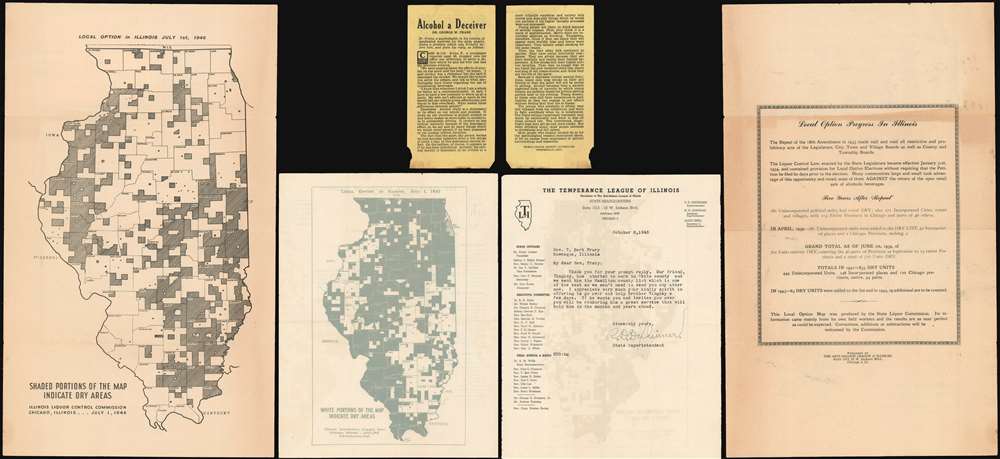This item has been sold, but you can get on the Waitlist to be notified if another example becomes available, or purchase a digital scan.
1948 TLI Maps of Illinois w/ 'Local Option' Dry Zones - post Prohibition Temperance!
Illinois-temperanceleague-1948$600.00

Title
Local Option in Illinois, July 1, 1947.
1948 (dated) 11 x 8.25 in (27.94 x 20.955 cm) 1 : 2500000
1948 (dated) 11 x 8.25 in (27.94 x 20.955 cm) 1 : 2500000
Description
Two 1940s maps of Illinois, accompanied by a flyer, highlight the progress of post-Prohibition Era temperance under 'Local Option' Laws. The maps date from 1946 (larger map) and 1947, and while largely representing similar data, the smaller map reverses the color coding to emphasize 'dry' zones. Following the 1933 repeal of the 18th Amendment, townships, city, county, and village boards were given the right to 'opt-in' to local Prohibition, a policy known a 'Local Option'. Temperance organizations like the 'Temperance / Anti-Saloon League' organized meetings and door-to-door grassroots campaigns to galvanize support for Local Option Laws. These documents offer a unique insight into their efforts.
Two Maps, a Letter, and a Brochure
The set includes two maps, printed front and back. The smaller map is actually the verso (back) of Temperance League of Illinois stationary and includes a typewritten letter to local organizer Reverend T. Bert Frary from the State Superintendent R. D. Dexheimer. In addition, there is a small yellow brochure entitled 'Alcohol a Deceiver' by George R. Crane (1901 - 1995), an Anti-Saloon League psychologist, physician, and conservative newspaper columnist.Local Option and Temperance in Illinois
'Local option' is defined as allowing a small political entity to determine controversial issues by popular vote. Illinois's first Local Option Law passed in 1839 and was repealed in 1841. The law grew out of an 1818 Illinois General Assembly action granting liquor licensing power to county officials. Over the course of the 19th century, temperance gained popularity in Illinois, particularly in and around Chicago. The influential Woman's Christian Temperance Union (WCTU) arrived in Chicago in the mid-1870s and aggressively advanced local temperance causes. In 1894, the Chicago City Council informally adopted a local option agreement allowing aldermen to designate small residential areas as 'anti-saloon territory'. Consequently, almost two-thirds of Chicago was dry by 1909 and National Prohibition in 1919 united Chicago's spotty dry districts. In 1934, after Prohibition's repeal, Illinois instituted a new formalized local option law. Communities across the state moved to pass temperance ordinances. In the 1970s and 1980s, a wave of anti-alcohol local measures arrived in African American and Hispanic American Chicago neighborhoods, where protests decrying the number of liquor establishments in their neighborhoods versus white suburbs. As a result, one-fifth of Chicago's precincts restricted the sale of alcohol by 2003. The opposite occurred in the suburbs, where restaurants lobbied successfully that serving alcohol would help revive depressed business districts.Publication History and Census
These maps were distributed by the Temperance League of Illinois (formerly the Anti-Saloon League of Illinois) in the late 1940s. No comparable examples are catalogued in institutional collections. One example of a similar 1939 map is part of the collection at the Wisconsin Historical Society.Cartographer
The Temperance League of Illinois (1898 - Present) is a non-profit organization in Illinois 'dedicated to preventing problems caused by alcohol, other drugs, and gambling'. Founded in 1898 as the Anti-Saloon League, the organization changed its name to the Temperance League of Illinois on May 22, 1948. It became the Illinois Church Action on Alcohol Problems (ILCAAP) on June 3, 1963. It is unclear when 'and Addiction' was officially added. More by this mapmaker...
Condition
Good. Light wear along original fold lines.

